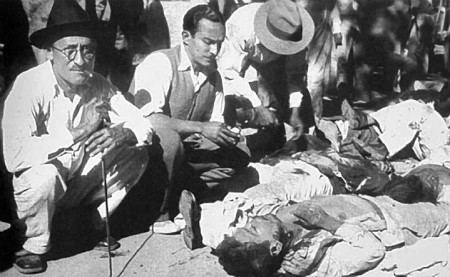Dates 22 Jan 1932 – 11 Jul 1932 | Location El Salvador | |
 | ||
Salvadoran rebels Government of El Salvador (Armed Forces of El Salvador) Result Uprising suppressed by government Similar Salvadoran Civil War, Football War, Peasants' Revolt, 1954 Guatemalan coup d'état, Battle of Acajutla | ||
1932 salvadoran peasant massacre
The 1932 Salvadoran peasant massacre occurred on January 22 of that year, in the western departments of El Salvador when a brief peasant-led rebellion was suppressed by the government, then led by Maximiliano Hernández Martínez. The Salvadoran army, being vastly superior in terms of weapons and soldiers, executed those who stood against it. The rebellion was a mixture of protest and insurrection and ended in ethnocide, claiming the lives of anywhere between 10,000 and 40,000 peasants and other civilians, many of them indigenous people.
Contents
Background

Social unrest in El Salvador had begun to grow in the 1920s, primarily because of the perceived abuses of the political class, and the broad social inequality between the landowners and the peasants,. The policies of the latifundia had left 90 percent of the country's land in the hands of 14 families, 'los catorce', who used the land for the cultivation of the cash-crop coffee. The unrest was only strengthened by the tremendous drop in the price of the coffee bean during the Great Depression accompanied by growing unemployment rates.
The national coffee-growing industry arose from the accumulation of riches of a small group of landowners and merchants who had purchased large portions of land and employing a great number of peasants, many of them indigenous.
Politically, El Salvador had been ruled since 1871 by economic liberal elites who had established what became known as the "Coffee Republic", which had given the country a long period of comparative stability and a liberal constitution in 1886. By World War I, the presidency rotated effectively between the Meléndez and Quiñónez families in quasi-dynastic succession. In 1927, Pío Romero Bosque was elected President and embarked on political liberalisation that led to what was arguably the first free election in Salvadoran history in 1931, won by the reformist Arturo Araujo. However, this period of pluralist democracy was not to last.
The coup
Unrest spread among military officers. In December 1931, with the collapse of coffee prices, the military's dissatisfaction peaked. A group of young officers, led by vice president Maximiliano Hernández Martínez, staged a coup and ousted Araujo. Araujo fled the country and Martínez assumed power.
The uprising
Though Martínez's rule may have satisfied the military, popular discontent continued to build and the government's opponents continued to agitate. Within weeks, communists, believing the country was ready for a peasant rebellion, were plotting an insurrection against Martínez. However, the government learned of the plot and arrested most of the ringleaders.
Nonetheless, actual fighting broke out on January 22, 1932. Rebels led by the communist party and Agustín Farabundo Martí, Mario Zapata and Alfonso Luna, attacked government forces with support that was largely from Pipil Indians in the western part of El Salvador. Within three days, they had succeeded in taking control of several towns, disrupting supply lines to many of the country’s towns and villages, and attacking a military garrison. With their superior training and technology, the government troops needed only a few days to defeat the rebels. While the rebels killed fewer than 100 people, the military retaliated with great force. The government responded to the uprising with great brutality with between 10,000 and 40,000 peasants, including Martí dying in the uprising. As the killings particularly targeted people of indigenous appearance, dress, or language, in the decades that followed, Salvadoran indigenous peoples increasingly abandoned native dress and languages from fear of further reprisals.
The towns of Nahuizalco, Juayua, Apaneca and Izalco were assaulted by the army. Feliciano Ama, an Indian leader, was hanged and this event was shown on postage stamps of the time. Following the Matanza, from 1932 to 1979, military officers held the presidency, with some presidents using more repression than others. Some of the perceived problems of El Salvador included an unfair minimum wage, repression against student and general demonstrations, and election fraud.
